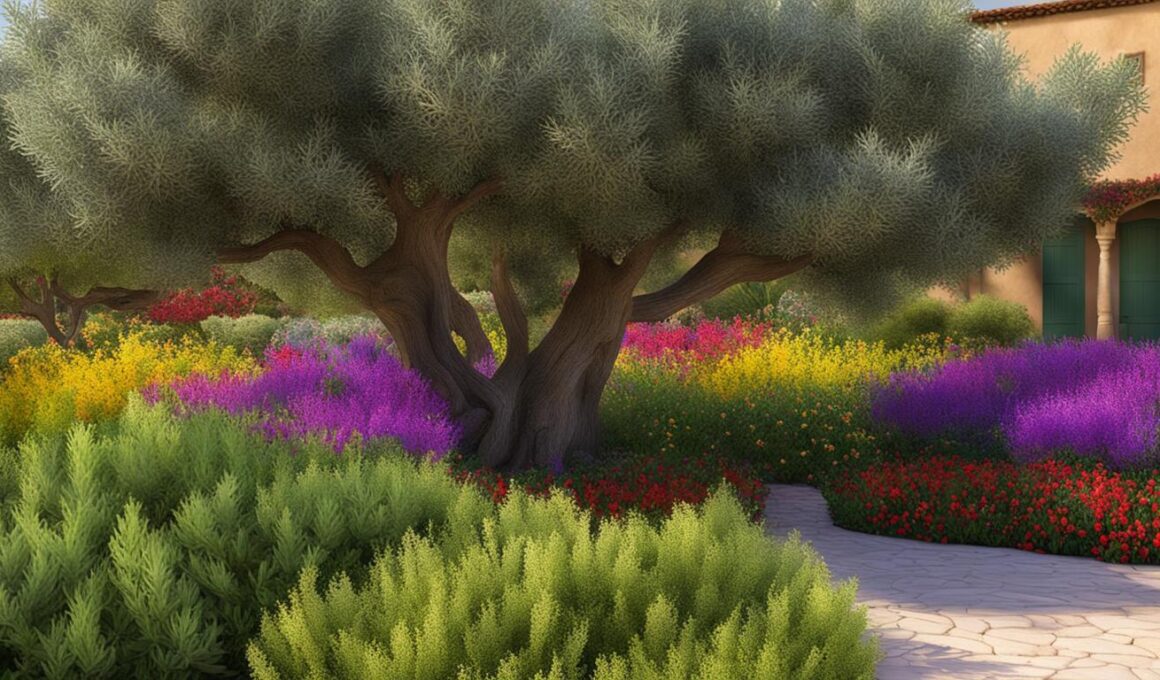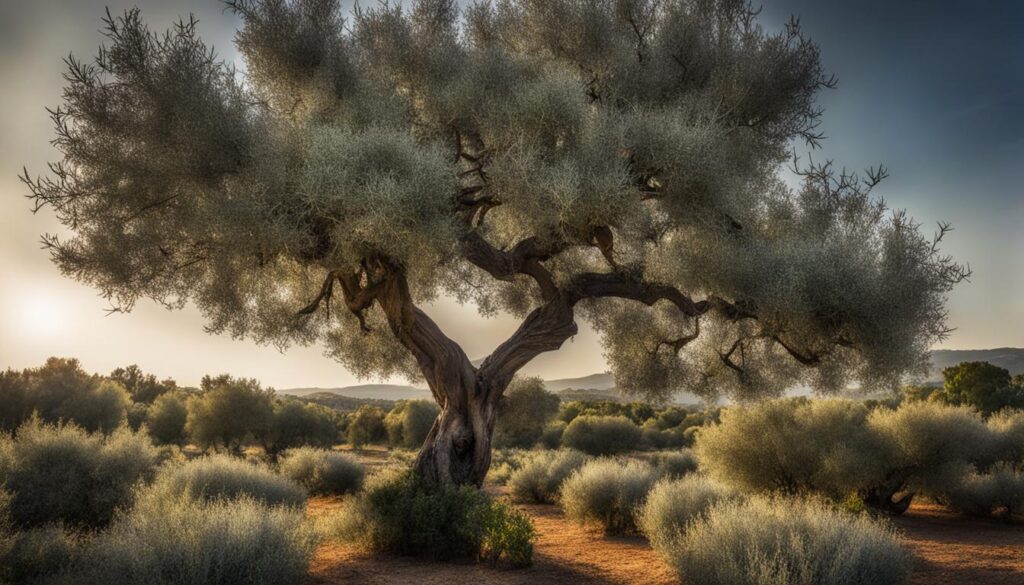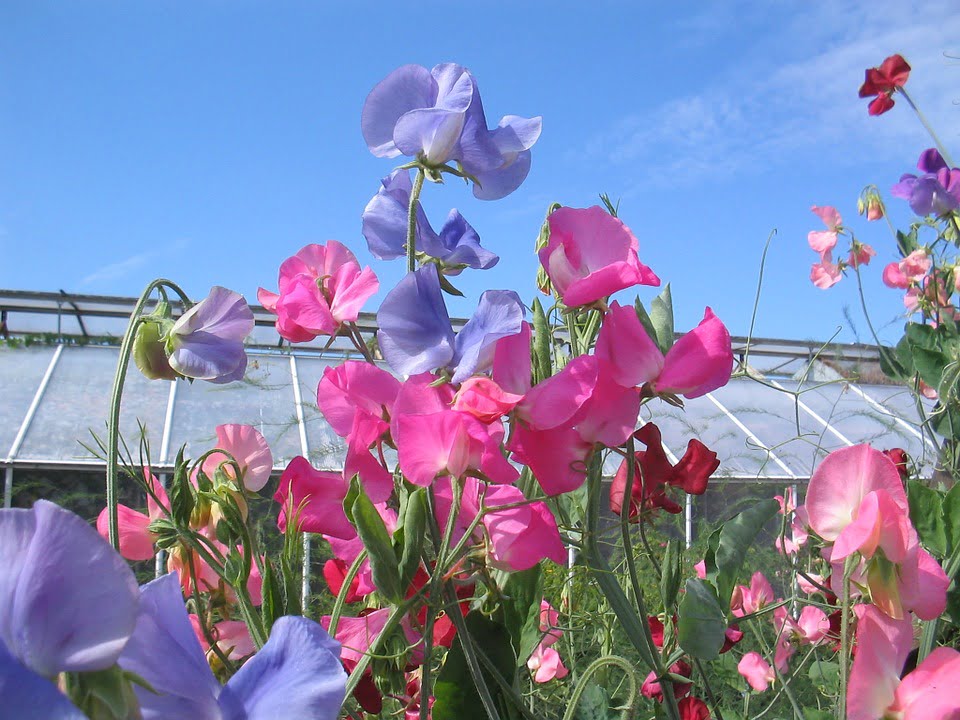Enhance the beauty of your garden with the addition of companion plants for your olive trees. These complementary plants not only provide visual interest but also contribute to the overall health and growth of your olive trees. Whether you have a small backyard garden or a spacious outdoor landscape, there are companion plants that will perfectly complement your olive trees.
Post Summary
- Companion plants can enhance the beauty and health of olive trees in your garden.
- Lavender, thyme, bunch grasses, oregano, and bulbs are excellent companion plants for olive trees.
- Consider the size, color, and overall landscape when selecting companion plants.
- Companion plants provide visual interest and contribute to the growth of olive trees.
- Create a harmonious garden by pairing your olive trees with the right companion plants.
Under-Planting Options for Olive Trees
If you’re looking to enhance the beauty of your olive trees, consider under-planting them with Mediterranean shrubs and ground covers. These plants not only complement the natural aesthetics of olive trees but also provide practical benefits such as water conservation and easy access to your harvest. While grass lawns may require excessive watering, certain ground covers are a suitable match for olive trees.
When selecting plants for under-planting, it’s important to consider their water needs and how easily you can harvest from your olive tree. Choose plants that have similar water requirements to ensure efficient irrigation and avoid competition for resources. Additionally, opt for plants that won’t impede your ability to harvest olives when the time comes.
Under-Planting Options for Olive Trees:
- Lavender: This aromatic herb not only produces beautiful purple flowers but also attracts beneficial insects to your garden.
- Thyme: With its low-growing habit and delicate leaves, thyme creates a lovely carpet-like effect under your olive tree.
- Rosemary: Known for its culinary uses, rosemary is a versatile plant that thrives in Mediterranean climates and adds a lovely fragrance to your garden.
- Creeping Rosemary: Similar to regular rosemary, creeping rosemary has a trailing habit that cascades down slopes or containers.
- Oregano: This culinary herb not only adds flavor to your dishes but also forms a dense ground cover under your olive tree.
- Bulbs: Plants like daffodils, tulips, and crocuses can be planted around the base of your olive tree to add vibrant colors when they bloom.
Benefits of Olive Trees in Container Gardens
There are several advantages to growing olive trees in container gardens. Firstly, containers allow for better control over the soil conditions, ensuring optimal growth for the tree. Secondly, the portability of containers allows you to move the tree to different areas of your garden, depending on sunlight requirements or aesthetic preferences.
Additionally, container gardening with olive trees allows for easy maintenance. Pruning and shaping the tree can be done more conveniently in a container, resulting in a well-maintained and visually appealing tree. Lastly, olive trees in containers create a beautiful focal point, adding a touch of Mediterranean charm to your outdoor space.
| Companion Plants | Description |
|---|---|
| Rosemary | Fragrant herb with needle-like leaves and blue flowers. |
| Sage | Aromatic herb with silvery-green leaves and purple-blue flowers. |
| Oregano | Flavorful herb with small, dark green leaves and pink flowers. |
| Thyme | Fragrant herb with tiny, green leaves and white or pink flowers. |
| Lavender | Fragrant plant with purple flowers and silvery-gray foliage. |
Olive Trees as Focal Points
Olive trees have a unique beauty that makes them a perfect choice for creating striking focal points in any garden or landscape. Their contorted branches and silvery-green foliage create a sculptural interest that draws the eye and adds a touch of elegance to any outdoor space.
One way to maximize the impact of olive trees as focal points is by planting them in pairs. This creates a sense of symmetry and balance, making them even more visually captivating. You can also use olive trees to flank entrances or water features, framing them and making them stand out.
When incorporating olive trees as focal points in your landscaping, consider the overall design of your outdoor space. Their shape, color, and texture can provide a beautiful contrast against a dark backdrop or soften the boundaries of your garden.
Benefits of using olive trees as focal points:
- Unique and sculptural beauty
- Brings elegance and sophistication to the landscape
- Creates focal points of interest
- Can be used in pairs or to flank entrances and water features
- Provides a beautiful contrast against a dark backdrop
- Softens garden boundaries
“Olive trees have a timeless appeal and can serve as stunning focal points in any garden. Their contorted branches and silvery-green foliage create a visual interest that draws attention and adds a touch of sophistication to outdoor spaces.”
Whether you’re designing a courtyard garden, terrace, or a larger landscape, incorporating olive trees as focal points can elevate the overall aesthetic and create a memorable visual impact. Their natural beauty and versatility make them an excellent choice for any landscaping project.
| Pros | Cons |
|---|---|
| Adds elegance and sophistication to outdoor spaces | May require regular pruning to maintain desired shape |
| Creates visually captivating focal points | Some varieties may be more susceptible to pests and diseases |
| Can be used in various garden styles and designs | May have specific soil and watering requirements |
| Provides a beautiful contrast against dark backdrops | Not suitable for all climates |
Creative Pruning Techniques for Olive Trees
Olive trees offer more than just their delicious fruit and striking appearance. With creative pruning techniques, you can transform these trees into captivating works of art. Pruning not only helps maintain the health and shape of olive trees but also adds sculptural interest to your landscape. Whether you prefer a formal, symmetrical design or a more natural, free-form look, pruning allows you to customize the appearance of your olive trees to suit your personal style.
One popular technique for pruning olive trees is cloud pruning. This method involves carefully shaping the branches to resemble fluffy clouds, creating an eye-catching focal point in your garden or terrace. The contorted branches of olive trees lend themselves well to this technique, adding a touch of elegance and artistry to your outdoor space.
When pruning olive trees, keep in mind their resilience and ability to withstand extreme weather conditions. These trees are adaptable and can thrive in various climates, from extreme heat to drought and even cold temperatures. However, it’s important to prune at the right time to avoid stressing the tree. Prune during the dormant season, typically in late winter or early spring, before new growth begins.
Pruning olive trees not only enhances their aesthetic appeal but also promotes better air circulation and sunlight penetration, leading to healthier tree growth. Regular pruning can also help manage the tree’s overall size and shape, preventing it from becoming too unruly or overgrown.
Olive Trees in Courtyard Gardens
If you have a sunny and sheltered courtyard garden, olive trees can be an excellent addition. These versatile trees thrive in courtyard conditions and can bring a touch of the Mediterranean to your outdoor space. Consider planting olive trees in raised beds to create a focal point and enhance the sun exposure. Varieties like ‘Arbequina’ and ‘Cipressino’ are particularly well-suited for courtyard gardens.
| Type of Olive Tree | Size | Preferred Sun Exposure | Watering Needs |
|---|---|---|---|
| ‘Arbequina’ | Medium-sized tree | Full sun | Low to moderate |
| ‘Cipressino’ | Small to medium-sized tree | Full sun | Low to moderate |
When selecting olive trees for your courtyard garden, consider the size and the overall landscape. Olive trees can provide a beautiful focal point and contribute to the overall aesthetic of the space. The contorted branches and silvery leaves of olive trees create a unique visual appeal that can enhance the ambiance of your courtyard garden.
“The combination of olive trees in raised beds and the Mediterranean feel of a courtyard garden can create a tranquil and inviting space where you can relax and unwind.”
– Garden Design Magazine
To keep your olive trees healthy in a courtyard garden, provide them with adequate water and regular pruning to maintain their shape. Olive trees are drought-tolerant, but they still require some water to thrive. Monitor the moisture levels in the soil and water accordingly, ensuring that the soil never becomes waterlogged.
In conclusion, olive trees are an excellent choice for courtyard gardens. Their resilience and ability to thrive in sunny, sheltered conditions make them the perfect addition to your outdoor space. Consider planting olive trees in raised beds to create a visually striking focal point. Choose varieties like ‘Arbequina’ and ‘Cipressino’ for the best results. With proper care and maintenance, olive trees can bring a touch of the Mediterranean to your courtyard garden and create a serene and inviting atmosphere.
Olive Trees in Front Yard Landscaping
Your front yard is the first impression visitors have of your home, so why not make it memorable with the striking presence of olive trees? These versatile trees can add a touch of elegance and Mediterranean charm to your landscape while serving as boundary softeners. Whether you choose to plant them as standalone trees or use them to create a row against fences, olive trees are a perfect choice for front yard landscaping.
Creating Boundaries with Olive Trees
Olive trees have a unique shape, with their contorted trunks and silvery-green foliage, making them excellent candidates for softening boundaries in your front yard. By planting a row of olive trees along your property’s edge or against a fence, you can create a natural barrier that adds privacy and visual interest. The dense foliage not only provides shade but also acts as a shield from noise and pollution, creating a tranquil outdoor space.
Enhancing Curb Appeal
The distinctive shape and texture of olive trees make them a captivating focal point in front yard landscaping. Their contorted branches and silvery-green leaves create an eye-catching display that draws attention and adds depth to your outdoor space. By strategically placing olive trees near entranceways or alongside water features, you can create a welcoming atmosphere that elevates your home’s curb appeal.
Moreover, olive trees offer a timeless beauty that complements various architectural styles, ranging from modern to traditional. Whether you have a contemporary or rustic front yard, olive trees can seamlessly blend into the overall aesthetic, enhancing the visual appeal of your home.
Low Maintenance and Drought Tolerance
One of the advantages of incorporating olive trees into your front yard landscaping is their low maintenance requirements. These trees are highly adaptable and can tolerate a wide range of soil conditions, including poor soils and coastal areas. Additionally, olive trees are known for their resilience and can thrive in both hot and cold climates.
Furthermore, olive trees are drought-tolerant once established, making them ideal for regions with limited water resources or dry climates. By choosing olive trees for your front yard, you can enjoy their beauty without the need for excessive watering or constant maintenance.
| Benefits of Olive Trees in Front Yard Landscaping | Examples of Olive Tree Varieties |
|---|---|
|
|
Illuminating Olive Trees at Night
Transform your outdoor space into a mesmerizing oasis by illuminating your olive trees at night. Olive trees with textured trunks can become stunning focal points, creating a magical ambiance that adds beauty and depth to your garden. By strategically placing LED lights inside pots planted with olive trees, you can achieve a breathtaking effect that enhances the natural beauty of these majestic trees.
The textured trunks of olive trees come to life under the soft glow of nighttime lighting. The intricate patterns and gnarled bark create fascinating shadows and highlights, showcasing the unique character of each tree. The combination of the tree’s distinctive silhouette and the gentle illumination from the lights adds a touch of elegance and sophistication to your outdoor space, creating a captivating visual experience.
By emphasizing the textured trunks of olive trees, the illuminated night display can also serve as a practical wayfinding feature. The soft glow of the lights can help guide visitors along walkways or highlight the entrance to your garden. Whether you’re hosting an evening gathering or simply enjoying a peaceful night in your outdoor sanctuary, the illuminated olive trees will provide a stunning backdrop that sets the mood and adds a touch of enchantment.
So, why not take advantage of the textured trunks of your olive trees and utilize outdoor tree lighting to create a magical atmosphere in your garden? Let the soft glow of LED lights accentuate the beauty and unique features of these magnificent trees, transforming your outdoor space into a captivating sanctuary that can be enjoyed day and night.
| Benefits of Illuminating Olive Trees at Night | Guidelines for Outdoor Tree Lighting |
|---|---|
|
|
Illuminate your olive trees at night and create a captivating outdoor experience that will leave you and your guests in awe. Let the textured trunks come to life under the soft glow of LED lights, adding a touch of magic and sophistication to your garden. Follow the guidelines for outdoor tree lighting and unleash the full potential of your olive trees as stunning focal points in your outdoor oasis.
Conclusion
Olive trees are extremely versatile and can be enhanced with the addition of carefully chosen companion plants. When selecting companion plants for your olive trees, consider factors such as size, color, and how they will fit into the overall landscape of your garden.
Lavender is a popular choice, as its vibrant purple flowers create a beautiful contrast against the silvery-green leaves of the olive tree. Dasylirion, also known as desert spoon or sotol, adds a touch of elegance with its spiky foliage and dramatic architectural form.
Incorporating palm trees can create a stunning tropical vibe and add height to your garden. Festuca glauca, commonly known as blue fescue, is a low-growing grass that complements the olive tree’s Mediterranean aesthetic with its tufts of silvery-blue foliage. These are just a few examples of the many companion plants that can enhance the beauty and visual impact of your olive trees.
Whether you choose to under-plant your olive trees, create focal points, or incorporate them into specific garden designs, the right companion plants can elevate their beauty and create an inviting and harmonious outdoor space. Experiment with different combinations and find the perfect companions for your olive trees to truly make them shine.
Can Rhododendrons Be Used as Companion Plants for Olive Trees?
Yes, growing rhododendrons in sunlight is not a problem. Rhododendrons can make great companion plants for olive trees. They provide beautiful blooms and can help control erosion around the base of the tree. However, it’s important to consider the water and nutrient needs of both plants before planting them together.
FAQ
Can I enhance my olive trees with companion plants?
Yes, olive trees can be enhanced with the addition of complementary plants such as lavender, thyme, bunch grasses, oregano, and bulbs.
What are some options for under-planting olive trees?
Mediterranean shrubs and ground covers are good options for under-planting olive trees. Grass lawns require too much water, but some ground covers are suitable.
How can I use olive trees to enhance my outdoor spaces?
Olive trees can create visual impact and enhance outdoor spaces. They can be used as a focal point in a courtyard garden or terrace. Planting a row of olive trees can soften boundaries and make them stand out against a dark backdrop.
Can I grow olive trees in container gardens?
Yes, olive trees can thrive in container gardens. They can be paired with fragrant herbs like rosemary, sage, oregano, and thyme, as well as lavender. When planting in a container, use a loam-based compost and ensure proper drainage. Olive trees in containers should be placed in a sunny position and watered regularly during the growing season.
How can I use olive trees as focal points in my landscaping?
Olive trees can serve as striking focal points in a garden. Their contorted branches create sculptural interest and draw attention. They can be planted in pairs to create symmetry or used to flank entrances and water features.
Can olive trees be pruned into different shapes?
Yes, olive trees can be pruned into smart shapes or left to grow more naturally. Cloud pruning is a popular technique that adds a stylish sculptural touch to terraces and gardens. Olive trees are resilient and can withstand extreme heat, drought, and cold temperatures.
Where are olive trees best suited in courtyard gardens?
Olive trees thrive in sunny, sheltered positions in courtyard gardens. They can be planted in raised beds to provide more sun and draw attention. Varieties like ‘Arbequina’ and ‘Cipressino’ are ideal for courtyard conditions.
How can I incorporate olive trees into my front yard landscaping?
Olive trees can make a statement in front yard designs. They can be planted as standalone trees or in rows against fences to soften boundaries and add interest with their shape, color, and texture.
Can I illuminate olive trees at night?
Yes, olive trees with textured trunks can be transformed into beautiful focal points when illuminated at night. LED lights can be placed inside pots planted with olive trees to create a stunning effect.
What are some companion plants that pair well with olive trees?
Lavender, dasylirion, palm trees, and festuca glauca are just a few options for companion plants that pair well with olive trees. Consider the size, color, and overall landscape when selecting companion plants for olive trees.











